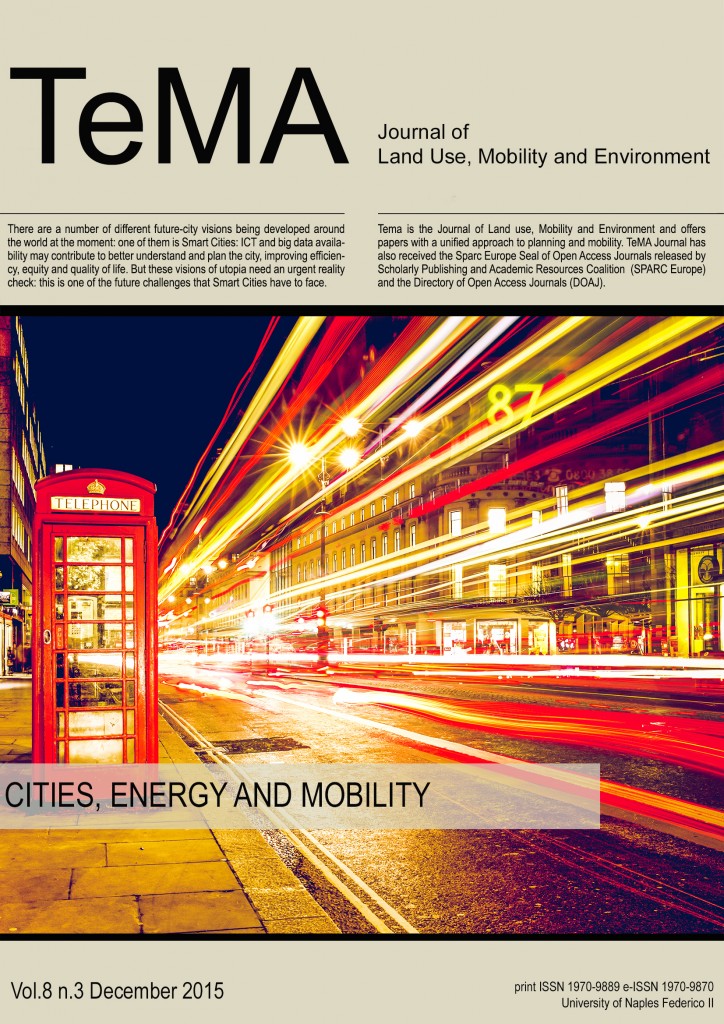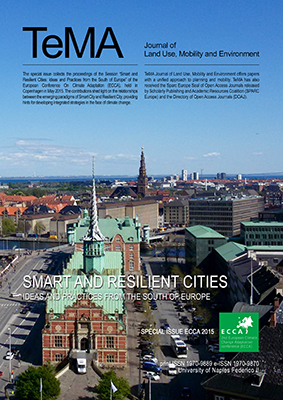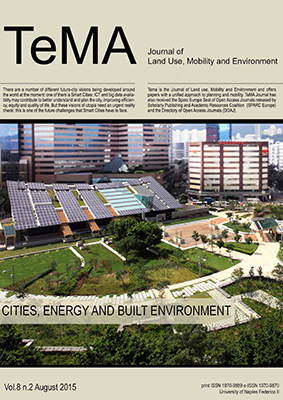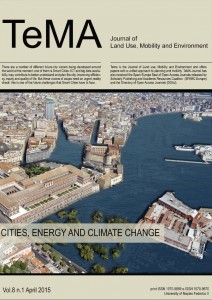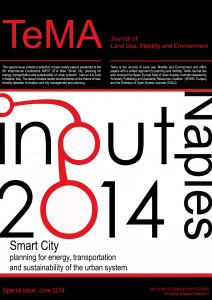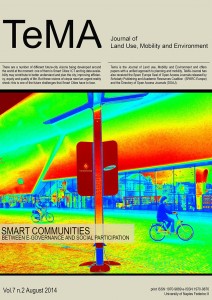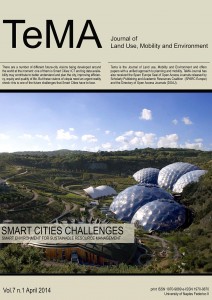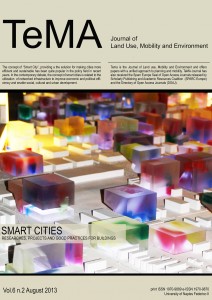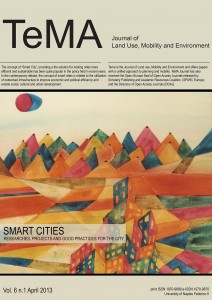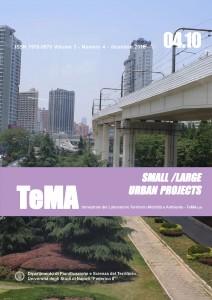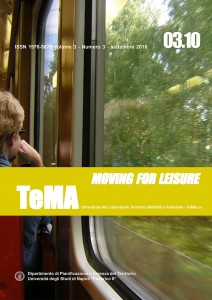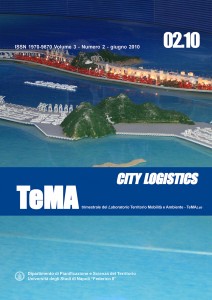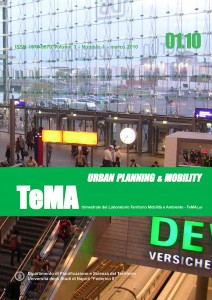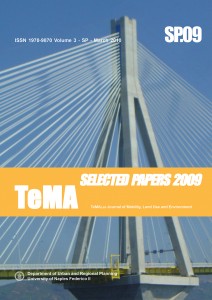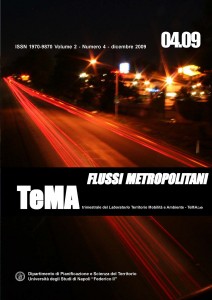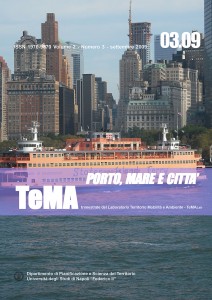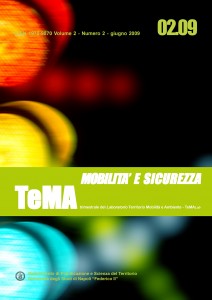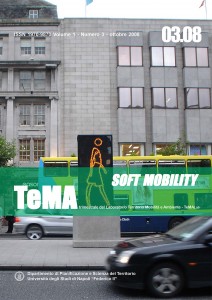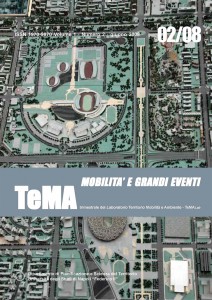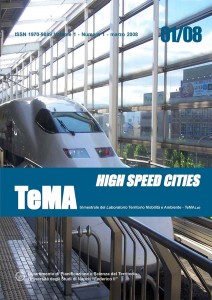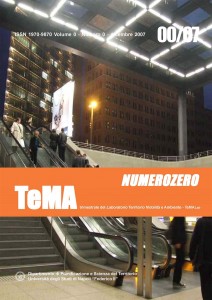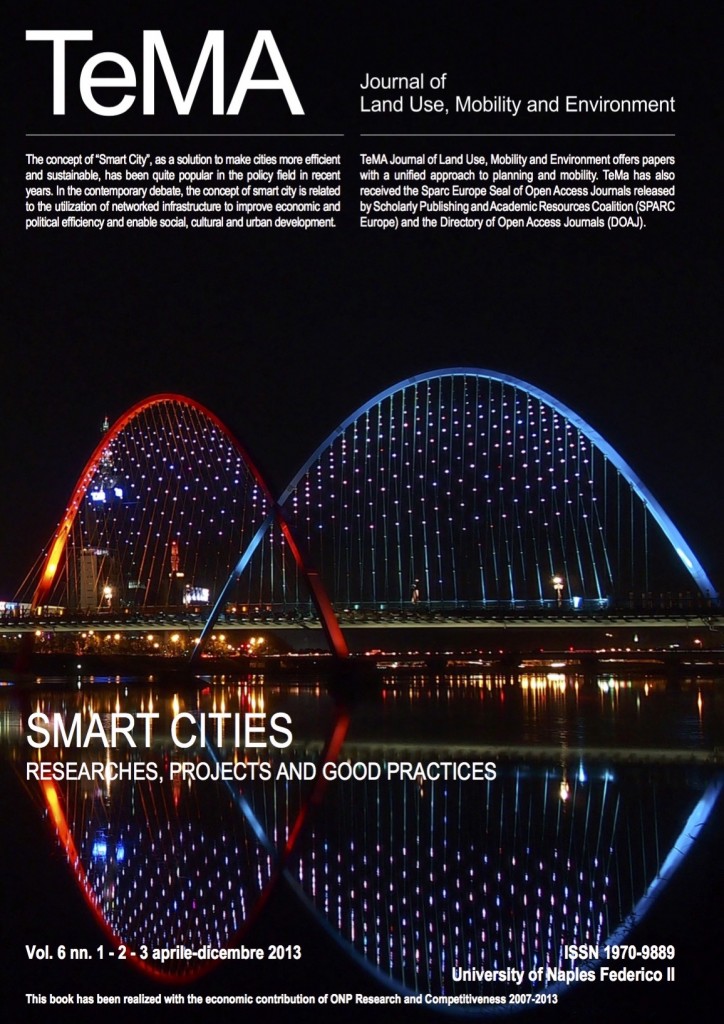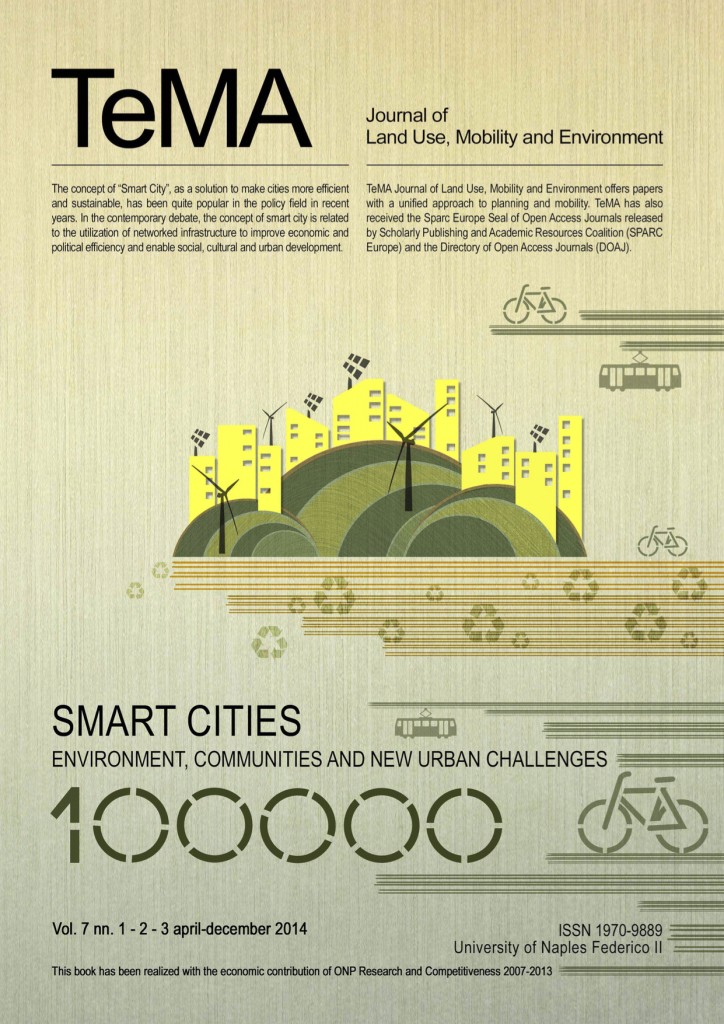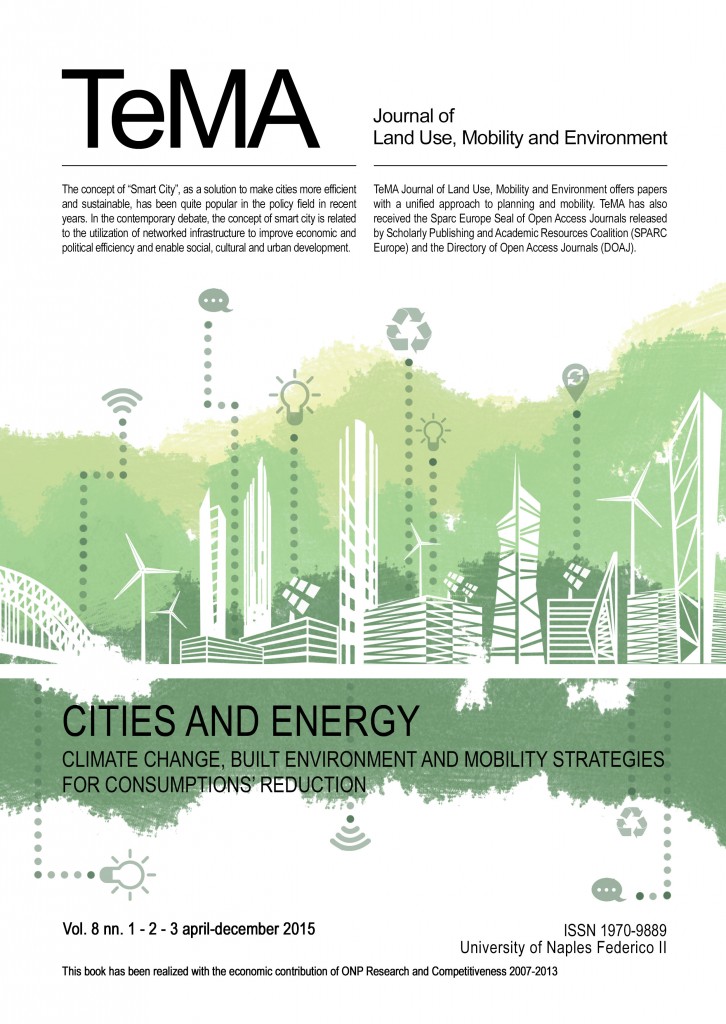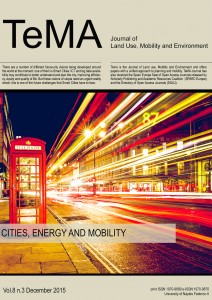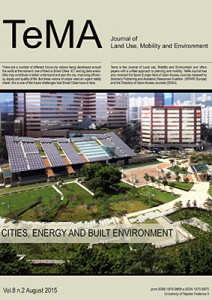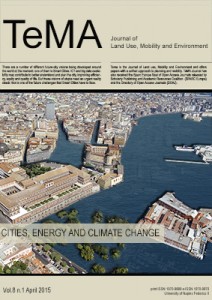
| Overview | About the Journal | How does it work | Up to Date | Download |
In questa sezione è possibile scaricare i file pdf dei singoli numeri di TeMA e i file pdf dei volumi 2013, 2014 e 2015.
![]()
_
_
_
_
_
![]()
Vol 8, N° 3 (2015)
Cities, Energy and Mobility: Strategies for Consumptions’ Reduction
Transport energy consumption accounts for about one third of total energy consumption in the EU. Despite significant advances in technology, energy consumption in transport sector has increased in most EU countries over the last three decades. Long-term forecasts suggest that energy consumption will further increase in all major sectors, experiencing the most rapid growth in the transport sector.
ECCA 2015
Smart and Resilient Cities. Ideas and Practices from the South of Europe
The Special Issue the Tema Journal of Land Use, Mobility and Environment, collects the proceedings of one of the Sessions framed into the second European Conference on Climate Adaptation (ECCA 2015) held in Copenhagen in May 2015 and promoted, among the others, by the EU Commission, the City of Copenhagen, The European Environment Agency, beside some European research projects (BASE, RAMSES and TopDad). The Session, “Smart and Resilient Cities. Ideas and practices in the South of Europe”, was addressed to highlight whether and how the emerging paradigms of Smart City and Resilient City may contribute to a better framing of climate strategies at city level and to explore research outcomes, best practices and existing barriers to the development of integrated climate strategies in the Southern European Cities.
Vol 8, N° 2 (2015)
Cities, Energy and Built Environment
The improvement of energy efficiency is one of the main challenges for addressing the objectives set by the EU 20-20-20 Strategy. Cities are responsible for two-thirds of global energy consumption and this proportion is expected to grow further. Cities represent complex systems in which physical assets, strategic and economic activities as well as the most of the world population are concentrated. Hence, to achieve relevant and enduring results in addressing energy efficiency issues, it is necessary to broaden our vision from the building scale to the whole urban structure. Urban planning is more and more considered as a crucial element in the long-term energy efficiency strategies. Hence, relevant and enduring results in addressing energy efficiency issues, can be achieved broadening our vision from the building scale to the whole urban structure and taking into account the relationships between the different urban components and energy.
Vol 8, N° 1 (2015)
Cities, Energy and Climate Change
Urban population is rapidly reaching two thirds of the global population; thus, cities are the core of a change that need to be driven: the rapid urban population growth involve a large energy consumption and high greenhouses gas emissions which drive cities to face environmental challenges like as climate changes and energy resources’ scarcity. As remarked by the last Report of the United Nations on Sustainable Development, climate change is one of the greatest challenges of our time and adequate strategies capable of mitigating and adapting to its impacts represents an immediate and urgent global priority. This issue of the TeMA focues on the topic of Cities, Energy and Climate Change, focusing on current strategies addressed to mitigation and adaptation.
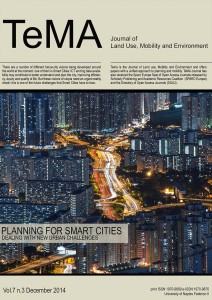
Vol 7, N° 3 (2014)
Smart City Challenges: Planning for smart cities. Dealing with new urban challenges
The role of urban planner is changing: ICT and big data availability, enabling them to monitor and analyse large amount of data and information, may contribute to better understand and plan the city, improving efficiency, equity and quality of life for its citizens and its capacity to face future challenges. Big data availability is shifting our focus away from the long to the very short term, affecting urban planner’s efforts on generating an effective knowledge base for planning.
INPUT 2014
INPUT 2014 – Smart City: planning for energy, transportation and sustainability of the urban system
This special issue collects a selection of peer-review papers presented at the 8th International Conference INPUT 2014 – Innovation in Urban and Regional Planning, titled “Smart City: Planning For Energy, Transportation and Sustainability of Urban Systems”, held on 4-6 June in Naples, Italy. The issue includes recent developments on the theme of relationship between innovation and city management and planning.
Vol 7, N° 2 (2014)
Smart Cities Challenges: Smart Communities Between E-Governance and Social Participation
Information and communication technology (ICT) is producing urban environments that are quite different from anything that we have experienced before. Cities are becoming smarter (or rather their population is becoming smarter) and can automate functions serving individual persons, buildings and traffic systems. At the same time, sensors streaming data, are giving rise to entirely new forms and patterns that enable us to watch how cities and their populations are responding in almost real time. Big data, open data, wireless sensor networks may represent basic tools for re-thinking our development model, decoupling economic growth from environmental degradation; re-designing our planning tools in face of the new challenges that cites have to deal with; creating inclusive and sustainable communities. The new ICT capabilities will allow the rising of a new dimension of the urban social capital and a new consciousness of citizens in the monitoring of the evolution process of the city.
Vol 7, N° 1 (2014)
Smart Cities Challenges: Smart Environment for Sustainable Resource Management
The role of urban planner is changing: ICT and big data availability, enabling them to monitor and analyse large amount of data and information, may contribute to better understand and plan the city, improving efficiency, equity and quality of life for its citizens and its capacity to face future challenges. Big data availability is shifting our focus away from the long to the very short term, affecting urban planner’s efforts on generating an effective knowledge base for planning.
This TeMA issue focuses on the theme of Planning for Smart Cities and invites contributions investigating innovative approaches, methods, techniques, tools for supporting urban and spatial plans (at different scales) on the following themes: Functional Densification; Social Housing; Urban Rehabilitation and Renewal; City Competitiveness in Economic Crisis; Brownfield Transformation; Maintenance, Upgrading and Innovation of Urban Infrastructures; Regeneration of Existing Building Stock; Reassessment of Urban Standards.
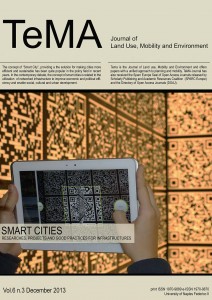
Vol 6, N° 3 (2013)
Smart Cities: Research, Projects and Good Practices for Infrastructures
The volume n.6 of TeMA Journal of Land Use, Mobility and Environment deals with the topic of Smart City and this third issue deals in particular with the theme of Smart Urban Infrastructural systems. The main subjects that this issue point out are innovation of networks and infrastructural systems for people and goods mobility; advanced technologies of communication; intelligent systems for energy production and distribution; monitoring systems for provision of real time information on different aspects of urban life (mobility, climate conditions, safety and so on). In this broader context one of the key theme is the role of ICT in innovating government and the policy decision processes: by enhancing the linkages between various governmental and social organizations, ICT supported knowledge flows (Socio Technical System) is a mean for sustaining innovation in the public sector since they enables governments to better cope with the uncertainties of a complex environment.
Vol 6, N° 2 (2013)
Smart Cities: Researches, Projects and Good Practices for Buildings
This issue of the volume n.6 “Smart Cities” focuses on ideas, projects and good practices with specific reference to the building scale, keeping in mind that the urban fabrics have to be seen not only as structure following the most advanced technological solutions but, above all, as constructions capable of an effective interaction with urban context, capable of reducing energy consumption, optimizing the use of space, minimizing impacts on natural resources, assuring the safety of inhabitants, also through an efficient use of available technologies.
Therefore, based on a systemic approach, this issue collects and promotes ideas, projects and good practices at building scale, able to affect the quality of everyday life, without ignoring the complex tissue of physical, functional and environmental relationships between buildings and the urban systems they belong to.
Vol 6, N° 1 (2013)
Smart Cities: Researches, Projects and Good Practices for the City
The concept of the smart city has been quite fashionable in the policy arena in recent years and the question of how we can live “smartly” in a city has become the focus of policymakers and private industry. The label smart city is still quite a fuzzy concept and is used in ways that are not always consistent. However, starting from a general definition, what is central to the concept of the Smart City and what makes it differ from ‘sustainable cities’ or ‘ECO cities’ is the use of Information and Communication Technologies (ICTs) in the process of creating a more sustainable city but also the availability and quality of knowledge communication and social infrastructure. This first issue of TeMA, Journal of Land Use, Mobility and Environment, volume no.6 deals with the subject of Smart City with reference to the urban scale. Accordingly, the papers tackle the different aspects characterizing a smart urban development: ranging from the more specifically economic ones, targeted to the implementation of strategies expected to improve competitiveness of cities in the global scenario; to those more involved in environment questions aimed at identifying strategies for improving the city capability of facing the important challenges given by the ongoing climate change as well as by the ever-growing reduction of traditional energy resources, paying particular attention to the improvement of urban mobility and energy saving as well as of those connected with the quality of life of communities, with specific attention to the participation to decisions-making processes, equity in the access to resources, individual and collective safety, social cohesion.
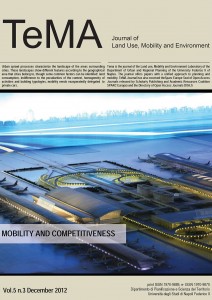
Vol 5, N° 3 (2012)
Mobility and Competitiveness
This issue focuses on the relations between competition among regions and cities and policies and/or infrastructural facilities related to mobility. In other words, the issue explores the contribution that infrastructural systems and/or procedures and tools for mobility planning and management can provide to the raise of the levels of competitiveness that cities achieve. The broad topic include both theoretical contributions and others more closely linked to policies/practices for mobility that positively affect the efficiency and livability of urban systems, increasing their potential for attracting businesses and families.
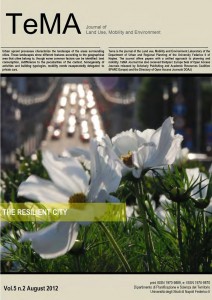
Vol 5, N° 2 (2012)
Resilient city
The Resilience concept has been largely debated in different disciplinary fields since the Seventies. An important contribution to the definition of Resilience itself and to the development of a peculiar focus on Urban Resilience has been recently provided by studies and researches on climate change. In this field, resilience has been defined as a set of adaptive capacities of urban systems dealing with different stress factors and, in particular, with phenomena of climate change and oil resources scarcity. A resilient city is defined as a city capable of absorbing shock and/or disturbances, without suffering significant alterations in its functional organization, its structure and identity features. According to these studies, this issue of TeMA focuses on national strategies and actions implemented both in European and in different national and urban contexts, in order to increase urban resilience in face of the main factors threatening their development and, in particular, of climate change, related natural hazards and oil resources scarcity.
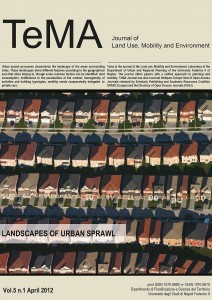
Vol 5, N° 1 (2012)
Landscapes of Urban Sprawl
Urban sprawl processes characterize the landscape of the areas surrounding cities. These landscapes show different features according to the geographical area that cities belong to, though some common factors can be identified: land consumption, indifference to the peculiarities of the context, homogeneity of activities and building typologies, mobility needs exasperatedly delegated to private cars. Furthermore, these processes increasingly develop while land use planning seems unable – due to the lack of capacities or of will – to counteract the causes, with multiple effects, which can be summarized in an overall reduction in quality of life.
Scientific community has been questioning about the need to curb urban sprawl processes for many decades, since when large suburbs have been changed from desirable residential places to areas characterized by poor relationships and social qualities.
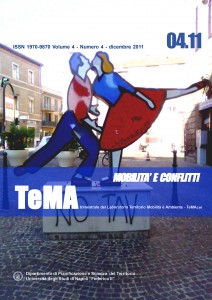
Vol 4, N° 4 (2011)
Mobilità e conflitti
L’esercizio, la realizzazione o la previsione di insediamento di un sistema di mobilità possono generare diverse forme di conflittualità. Queste ultime possono riguardare principalmente la sfera socio-territoriale ed il rapporto fra infrastruttura (in generale grandi sistemi di trasporto e scambiatori) e collettività locale, interessata dai mutamenti territoriali indotti e esposta agli impatti che si originano per effetto del sistema di trasporto. In prima ipotesi, è possibile identificare una serie di conflitti riconducibili a fattori quali: la tipologia di infrastruttura, la scala dell’intervento, il tipo di impatto generato, le caratteristiche delle collettività coinvolte, la distribuzione territoriale delle infrastrutture di mobilità, la tipologia di spostamento, ecc. Il numero si pone l’obiettivo di analizzare le possibili ed eterogenee forme di conflittualità, estendendo l’approfondimento anche a forme di conflitto che possono riguardare: le procedure di concertazione, i percorsi di ricerca del consenso, ma anche gli squilibri nell’erogazione del servizio ed i conflitti indotti fra classi diverse di utenti dalle nuove politiche di gestione delle infrastrutture (per esempio considerando le nuove opportunità di spostamento offerte dalla rete A/V). Un ruolo particolarmente rilevante va riservato alla riflessione sugli impatti, gli squilibri e le discrasie generate sul “sistema ambiente” dalle nuove infrastrutture di mobilità che intervengono a modificare gli assetti orografici e le specificità ambientali di siti di consistente valore (territori alpini, insulari, costieri, etc.) ambientale e per i quali sussiste un forte senso di appartenenza radicato nelle comunità locali.
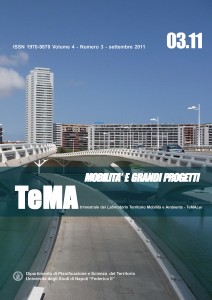
Vol 4, N° 3 (2011)
Mobilità e grandi progetti
Questo numero di Tema si occupa della realizzazione di grandi progetti infrastrutturali, con particolare riferimento al rapporto tra grandi progetti e competitività territoriale, alle tecniche e ai metodi per valutare gli impatti dovuti alla realizzazione di interventi nel settore dei trasporti, all’efficacia degli investimenti nel settore dei trasporti su scala europea, ai cambiamenti nei sistemi metropolitani indotti dall’attuazione dei progetti infrastrutturali, alla valutazione, 10 anni dopo la Legge Obiettivo, delle implementazioni di infrastrutture strategiche in Italia, agli impatti dei grandi progetti infrastrutturali sul paesaggio e sull’ambiente.
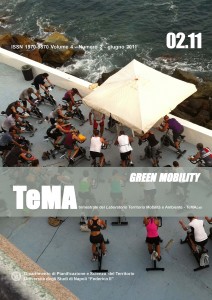
Vol 4, N° 2 (2011)
Green Mobility
La mobilità delle persone e delle merci è largamente riconosciuta quale presupposto imprescindibile per la crescita economica e lo sviluppo della società, elemento strategico per lo sviluppo competitivo di città e regioni e diritto fondamentale delle collettività. Nel contesto europeo i trasporti costituiscono uno dei settori economici più rilevanti ma, anche, uno dei principali fattori di deterioramento della qualità ambientale e della vivibilità, soprattutto nelle grandi aree urbane: inquinamento atmosferico e acustico, consumo di fonti energetiche non rinnovabili, consumo di suolo, congestione, incidentalità sono tra i principali costi ambientali connessi ai trasporti. Pertanto, questo numero di TeMA intende focalizzare l’attenzione sulle strategie e sulle messe in campo sia in ambito europeo che in diversi contesti nazionali ed urbani, per ri-orientare la politica dei trasporti verso obiettivi di sostenibilità, al fine di garantire una complessiva crescita della mobilità e, nel contempo, una significativa riduzione dei costi ambientali ad essa associati.
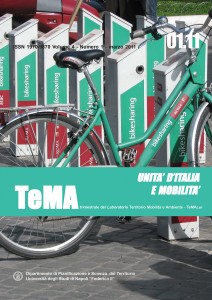
Vol 4, N° 1 (2011)
Unità d’Italia e Mobilità
L’unificazione italiana nel 1861 è stata l’inizio di grandi modifiche all’interno del paese, ha cominciato, tra gli altri, un processo di unificazione della rete di mobilità nazionale, per lungo tempo fossilizzata all’interno dei confini dei diversi stati . Il processo di unificazione si è basata sulle reti esistenti; il risultato fu che le aree attrezzate con le reti più avanzate sono state favorite, mantenendo la propria supremazia nella competizione con le aree meno sviluppate. Lo sviluppo della rete nazionale si è basata, per molto tempo, sul miglioramento della rete ferroviaria. Solo dopo l’inizio della motorizzazione di massa, dopo la seconda guerra mondiale, la rete autostradale ha prevalso assorbendo, a partire dagli anni Sessanta, la maggior parte degli investimenti nazionali.L’obiettivo di questo numero di TeMA è quello di indagare lo stato dei sistemi di mobilità in Italia secondo una prospettiva storica. L’unità italiana è stata, infatti, una opportunità rilevante per influenzare profondamente diversi settori, tra cui quello delle infrastrutture.
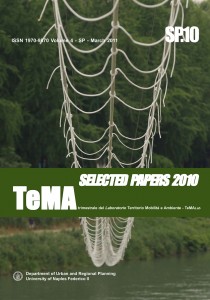
Selected Papers 2010
This special number is a selection of papers published in TeMA 2010 volume and is the second item completely in English. The selected papers are works previosly published in Italian and now presented in a different layout collected into a unique item.
Vol 3, N° 4 (2010)
Small/Large Urban Projects
Questo quarto numero dell’anno 2010 vuole fare il punto, con la illustrazione di progetti e casi di studio, sui processi di integrazione della progettazione e quindi della realizzazione delle infrastrutture di trasporto, puntuali o lineari, con gli interventi di trasformazione della città e del territorio. Nel vasto panorama degli interventi progettati o realizzati in questi ultimi anni, in Italia e all’estero, abbiamo privilegiato le due tipologie che consentono una sintesi più immediata degli approcci, dei sistemi di intervento, delle soluzioni progettuali adottate e dei problemi non risolti che questa metodologia pone in essere: i Large scale projects e gli Small projects.
Vol 3, N° 3 (2010)
Moving for Leisure
Partendo dalla consapevolezza che lo spostamento sia una condizione necessaria allo svolgimento della pratica turistica tout court e di quella urbana in particolare, il numero affronta il tema della mobilità turistica nelle aree urbane, analizzando alcuni principali interventi messi in campo per adattare l’offerta di trasporto alle richieste di un’utenza temporanea ma con una forte incidenza sul bilancio economico della città.
Vol 3, N° 2 (2010)
City Logistics
Il numero affronta il tema della city logistics, ovvero di quel settore della logistica che studia ed attua soluzioni per l’ottimizzazione del trasporto delle merci nelle aree urbanizzate. In un’epoca in cui il fenomeno dell’urbanizzazione è a livelli mai prima raggiunti la city logistics rappresenta un tema di grande attualità sia per il trasporto merci, attività essenziale per la sopravvivenza delle persone, che per la qualità della vita, atteso che il trasporto in genere e quello delle merci in particolare sono tra le cause principali dell’inquinamento ambientale.
Vol 3, N° 1 (2010)
Urban Planning and Mobility
Urban Planning and Mobility propone un approfondimento sul tema del governo integrato trasporti-territorio. Questa forma di coordinamento deve essere finalizzata al raggiungimento di un equilibrio tra le politiche urbanistiche come input per la programmazione dei sistemi di trasporto, mantenendo salda l’ipotesi che il sistema di trasporto è un determinante per l’evoluzione del sistema territoriale.
Vol 2 (2009)
Selected Papers 2009
This special number is a selection of papers published in TeMA 2009 volume and is the first item completely in English. The selected papers are works previosly published in Italian and now presented in adifferent layout collected into a unique item.
Vol 2, N° 4 (2009)
Flussi Metropolitani
Il numero Flussi Metropolitani propone un approfondimento sul tema della mobilità alla scala sovra-comunale ed in particolare sul sistema di relazioni esistenti tra i processi di espansione metropolitana e il ruolo della rete e dei sistemi di mobilità. L’espansione della città alla scala metropolitana modifica l’organizzazione dello spazio territoriale e dei sistemi coinvolti, in particolare quelli residenziali, ambientali, produttivi, delle attrezzature e dei servizi pubblici; non ultimo il sistema della mobilità, che innerva i territori e ne caratterizza l’efficienza, al punto che, in molti casi, i ritardi infrastrutturali arrivano a condizionarne l’organizzazione e la competitività.
Vol 2, N° 3 (2009)
Porto, mare e città
Questo numero di TeMA propone un approfondimento sul rapporto tra la città e il mare. L’idea guida è quella di considerare i waterfront urbani e i nodi portuali come aree di confine e allo stesso tempo di cerniera tra le aree metropolitane e il mare. I fronti marittimi urbani e le aree portuali, proiettati sul mare e parte integrante del contesto territoriale in cui sono localizzati, “aree sensibili” sia in termini fisico-funzionali che di pianificazione e gestione.
Vol 2, N° 2 (2009)
Mobilità e sicurezza
Questo numero di TeMA fornisce un approfondimento sul tema della sicurezza applicato ai sistemi di trasporto, che, come attrezzature di importanza strategica alla vita quotidiana delle comunità, costituiscono elementi esposti ad elevata vulnerabilità sia in relazione all’uso degli stessi, sia rispetto al verificarsi di fenomeni calamitosi. Il numero affronta i diversi aspetti del tema della sicurezza applicato ai sistemi di trasporto di persone e merci, per i diversi modi di trasporto e con differenti approcci.
Vol 2, N° 1 (2009)
Politiche della sosta e città
Il numero fornisce elementi di riflessione ed approfondimento sul ruolo del governo della sosta per la mobilità sostenibile nelle aree urbane, illustrando metodi, strategie, strumenti ed interventi da implementare attraverso lo studio della recente bibliografia e l’analisi di best pratices nazionali e internazionali.
Vol 1, N° 3 (2008)
Soft Mobility
Il numero affronta il tema della mobilità dolce (pedonale e ciclabile) alla scala urbana e alla scala vasta, attraverso riflessioni toeriche e studio di pratiche innovative in Italia ed in Europa.
Vol 1, N° 2 (2008)
Mobilità e grandi eventi
Il numero affronta il tema della pianificazione e gestione dei sistemi di trasporto e della mobilità in occasione dei grandi eventi. Attraverso riflessioni teoriche ed applicazioni, si analizzano le scelte messe in campo per rispondere alla necessità sia di rendere accessibile l’area dell’esposizione a grandi flussi di visitatori, sia di integrare le nuove opere nel disegno di sviluppo della città.
Vol 1, N° 1 (2008)
High Speed Cities
Questo numero della rivista affronta un argomento di grande interesse per chi vuole studiare le relazioni tra sistemi urbani e sistema della mobilità: le High Speed Cities. L’obiettivo è riflettere sui molteplici effetti, non ancora sufficientemente indagati, che l’entrata in esercizio dell’Alta Velocità ferroviaria può avere, da diversi punti di vista e a diverse scale, sull’organizzazione spaziale e funzionale dei sistemi urbani coinvolti.
Vol 1 (2007)
Numero Zero
Con il numero zero di TeMA, ed il lancio della nuova rivista l’intenzione è dare il nostro contributo alla costruzione di nuove competenze, scientifiche e allo stesso tempo professionali, su uno degli argomenti di sempre maggior interesse per chi studia e opera nei settori delle trasformazioni fisiche della città e del territorio: l’integrazione tra le discipline che studiano le trasformazioni urbane e quelle che affrontano le tematiche del governo della mobilità. Direi di più, forse è arrivato il momento di porci un obiettivo più ambizioso: costruire un nuovo corpus di conoscenze teorico-metodologiche che, superando gli steccati che segnano il confine – del tutto apparente – tra queste discipline, sia in grado di formulare soluzioni nuove ai problemi che oggi continuiamo ad affrontare con i vecchi arnesi della cultura scientifica del secolo scorso.




